Abstract
This study analyzes the market value of listed companies in Mainland China across different industries, including capital-intensive, labor-intensive, technology-intensive, and other industries. A generalized neoclassical investment model that considers physical capital, labor, and knowledge capital as input variables is built to theoretically decompose firm value. The empirical results indicate that knowledge capital accounts for an increasing proportion of the market value of companies, rising sharply from 21.5% in 2009 to 37.9% in 2018. In contrast, the share of labor in enterprise market value has been decreasing year by year, dropping from 56.5% in 2009 to 36.4% in 2018. The share of physical capital in enterprise market value remains relatively stable. Based on these findings, the study simulates the optimal investment behaviors and their influence on the firm value of various types of enterprises, providing valuable insights for investment decision-making for managers in different industries.
Keywords:
enterprise market value; dividend discount model; knowledge capital; physical capital; labor MSC:
91B38
1. Introduction
Enterprises are an essential part of the economic system. Firms use different kinds of factors, such as labor, physical capital, and technology, to produce goods and services; at the same time, they pay wages and interest and earn profit, which are the main sources of consumption and investment. To improve resource allocation efficiency and government management, research on firm values is necessary. In the new era, knowledge capital and other kinds of intangible capital play more and more important roles. Investigating the impact of different kinds of investments, especially investments in knowledge capital, on firm value has not only academic value but also practical value. On the one hand, the study of enterprise market value can provide appropriate guidance for real-world investment decisions, and on the other hand, analyzing the influencing factors of enterprise market value with different methods can help us compare the applicability of different theoretical models.
There has been extensive research on firm value and optimal investment decisions, both from theoretical and empirical perspectives. Several theories, for example, Tobin Q, the multi-capital Q model, the capital asset pricing model (CAPM), investment-CAPM, and intellectual capital theory, were used to analyze the factors influencing firm value and investment decisions [1,2,3,4,5]. Firms in the US, Japan, India, and other regions were chosen to analyze the factors affecting firm value [4,5,6,7,8]. The firm values of Chinese-listed companies have also been analyzed in recent years [9,10,11,12,13]. There are still some research gaps to be filled, as follows: (1) Most of the empirical research lacks an organic combination of theoretical model analysis, especially those for Chinese firms; (2) Different industries have different characteristics, so even the same kind of capital may have different impacts in different industries, and the existing literature has seldom investigated these differences; (3) The characteristics and impact mechanisms of optimal investment decisions have not been sufficiently studied.
To fill these research gaps, in this paper, we first build a generalized neoclassical investment model that contains three different kinds of capital: physical capital, labor, and knowledge capital, and incorporates quasi-fixed adjustment costs. Using Chinese firm data from 2009 to 2018, we analyze the dynamics of the proportions of these three kinds of capital in firm value decomposition for different kinds of industries. Furthermore, the characteristics and mechanisms of optimal investment decisions are investigated using simulation.
The analysis not only provides direct evidence of the importance of labor and knowledge capital in understanding Chinese firm market values but also illustrates the dynamics of their contributions to firm value. The neoclassical investment model provides a theoretical basis for firm value decomposition, and the optimal investment policies can provide guidance for managers. The empirical results show that for Chinese firms in the past decades, knowledge capital’s proportion to firm value has increased and labor’s proportion has decreased, while physical capital’s proportion has remained relatively stable. However, it is worth noting that Belo et al. [7] found that for US companies, knowledge capital’s proportion to firm value was increasing, and physical capital’s proportion was decreasing, while labor’s proportion was relatively stable. This difference shows the different development stages and endowments of Chinese and US economies and the necessity of empirical tests for different countries to validate the applicability of the theoretical models.
2. Literature Review
Enterprise value is an important characterization of the state of a company, which is closely related to its investment decisions and also affects the performance of the stock market, and it thus receives a great deal of attention. In 1983, Abel built a model to investigate the effect of output price uncertainty on optimal investment decisions that maximized firm values [14]. Then, in 1985, he further examined the relationships among the market value of the firm, marginal Q, and optimal investment rate theoretically [1]. In 1993, Chirinko used a multiple capital Q model to investigate the effect of investment spending and Q. In his model, the three inputs added to the model were inventory, research and development, and labor, which were treated as quasi-fixed factors [3]. Empirically, Hayashi and Inoue used a panel of Japanese listed firms to investigate the relationship between investment and Q [4]. Belo et al. designed a new supply approach for valuation and used the Q theory of investment to pin down the cross-sectional asset prices [15]. By introducing learning, Andrei et al. both theoretically and empirically proved that the investment-Q relation works better for research-intensive industries [16]. In addition, Gonçalves et al. showed that models based on investments in physical capital and working capital can capture the variation in average returns across a large number of portfolios simultaneously [2]. This study also demonstrated that the aggregation of physical capital and working capital in the Investment Capital Asset Pricing Model (ICAPM) helped to explain the variation in average returns across portfolios.
In the modern economy, intangible capital has become more and more important, and research has incorporated intangible capital to explain firm value. A growing body of literature suggests that intangible capital is progressively becoming more important for firms. Hall asserted that unmeasurable intangible capital was an important part of the modern economy [17]; McGrattan and Prescott showed the importance of accounting for intangible assets in the valuation of stock market value [18]. Carrado et al. investigated the importance of considering intangible capital in analyzing economic growth and suggested that intangible capital had made a significant contribution to labor productivity and, thus, economic growth [19]. Li and Liu emphasized the importance of intangible capital for measuring firm values and found that incorporating adjustment costs and investment-specific technological change improved the model performance [20]. Carrado and Hulten discussed the scope, characteristics, and measurement of intangible capital and showed the trend in intangible investment in the US economy [21]. Hansen et al. used securities market data to measure intangible capital and illustrated the importance of intangible capital when measuring firm value [22]. Falato et al. ascertained that the rise of intangible capital made US corporations hold more cash and less debt [23]. Peters and Taylor investigated the intangible capital and investment-Q relationship and found that Tobin’s Q can explain both physical and intangible investment [24].
Several kinds of capital were selected to represent intangible capital, for example, organization capital, customer capital, and brand capital. Eisfeldt and Papanikolaou posited that the intangible capital was embodied in the firm’s key employees’ organizational capital and found that firms with higher organizational capital would be riskier and have higher average returns [25]. Lev and Radhakrishnan viewed organization capital as the major factor in production and often brought firms abnormal returns, thereby incentivizing firm growth, underlining that it was a persistent creator of value and growth for firms. They showed that organizational capital contributed significantly to the explanation of firm value [26]. Gourio and Rudanko examined the impact of customer capital on firm value and investment dynamics, emphasizing the importance of adjustment costs in creating customer capital [27]. Belo et al. studied brand capital, the primary form of intangible capital, and proved that more brand capital-intensive firms had higher stock returns, showing the importance of intangible assets on firm value [28].
Intellectual capital is a kind of intangible capital that refers to collective knowledge and resources and can be categorized as human capital, relational capital, and structural capital. Researchers investigated intellectual capital from different perspectives and viewed it as a source of firm competitive advantage [29,30]. Ni et al. found evidence that for Taiwanese companies, intellectual capital positively affected firm values and suggested firms make efforts to develop intellectual capital [5]. Smriti and Das used the value-added intellectual coefficient model to measure intellectual capital and its components. They found that Indian-listed companies performed better when enhancing intellectual capital [6]. Lin et al. decomposed the firm’s unexpected stock returns into intellectual capital news and expected return news and found that intellectual capital news was the main driver of stock returns and excess stock returns, implying that intellectual capital played an important role in firm stock values [31]. Shafiee used a structural equation model to investigate the impact of intellectual capital on a firm’s competitive advantage and found that intellectual capital increased the competitive advantage by improving business intelligence and brand image [32].
Labor is an important input for production and growth, and the decisions of labor affect firm value. In 1986, Shapiro included labor adjustment costs in his analysis and found that the presence of labor adjustment costs played a key role in matching investment and dynamic employment [33]. However, in 2004, Hall showed that the introduction of excessive adjustment costs in the model setup was ineffective [34]. By analyzing the annual industry data for the US, Hall found that adjustment costs generate relatively small rental costs. This should not be an important factor in explaining the shift in the market capitalization of firms. Merz and Yashiv introduced the frictions of the labor market and treated labor as a quasi-fixed factor that affected firm value. The optimal hiring and investing determined the firm profit and, consequently, the firm market value [35]. Belo et al. studied the impact of labor market frictions on asset prices and found that, due to the adjustment cost, a 10% increase in a firm’s hiring rate would cause a 1.5% decrease in its risk premium [36]. Barkai used data on labor compensation in the US economy to track labor productivity and showed that after 1980, increases in labor productivity were accompanied by equally sized increases in labor compensation. The decline in the labor share was caused by sustained productivity growth and stagnant pay [37].
Recently, some researchers studied the factors influencing Chinese firm values. Li found that the development of the digital economy enhanced firm value [9]. Based on a text analysis method, Huang et al. empirically proved that the digital transformation increased Chinese listed firms’ value by increasing their innovation ability, factor allocation efficiency, and risk management [10]. Xu et al. found that increasing information density brought higher firm value, and social trust positively moderated the relationship [11]. Chen et al. investigated the capital–labor elasticity of substitution, biased technological progress, and factor-relative income shares of Chinese industrial firms and proved that changes in factor-relative prices affected their income shares. The results proved that changes in factor-relative prices affected factor-relative income shares mainly through direct ways and, to a lesser extent, through indirect ways [12]. Yan and Kong studied the effect of managerial competence on the enhancement of enterprise value and proved that a free and equal, neutral competitive environment and the enhancement of managerial competence were important means to increase enterprise value [13].
Studies have been conducted to analyze enterprise value both theoretically and empirically, and some valuable conclusions have been drawn. In terms of models, the portrayal of corporate behavior has become more and more detailed, the classification of capital has become more and more rational, and the importance of intangible capital has been recognized. In terms of empirical research, more and more samples have been used for the analysis of enterprise value and the testing of theories. On the basis of these studies, this paper will theoretically derive the decomposition of enterprise value by constructing a generalized neoclassical investment model, analyze the contribution of various types of capital to enterprise value by using the data of Chinese-listed companies, and portray the characteristics and mechanisms of the optimal investment behavior of enterprises. This contributes to the existing literature not only by providing a specific theoretical model for China—the largest developing country—but also by providing detailed descriptions of the evolution of proportions of different determinants of Chinese listed companies’ market values. The portrayal of optimal investment characteristics has practical guidance for managers and can help them make better investment decisions.
3. Theoretical Model
3.1. Model Description
Referring to the basic model of neoclassical investment for firm valuation in the studies of Cochrane [38], Ohlson [39], Liu et al. [40], and Belo et al. [7,28,37], we build a model that incorporates three different kinds of capital, that is, physical capital, labor, and knowledge capital, to investigate the value of firms. The model assumes that time is discrete and the number of periods is infinite. In each period, at a given price, the firm chooses the number of factor inputs to maximize the value of the firm based on the dividend discount rate. In this study, labor and physical and knowledge capital are considered quasi-fixed inputs. Therefore, labor costs and capital investments are excluded from the definition of operating profit. Based on these given operating profits, the firm chooses for itself the optimal allocation of physical capital, labor, and knowledge capital, with the ultimate aim of maximizing the market value of equity.
In this model, there is a cost to changing the amount of capital inputs and labor. This cost can be presented through a standard adjustment cost function. The model setup is realistic because, for physical and knowledge capital inputs, the adjustment costs then include planning and installation costs as well as various costs associated with production (e.g., temporarily interrupting the production line, changing to a new research and development plan, etc.). For labor, these costs also include the costs of hiring and firing workers and the cost of training new workers. The equilibrium market value of the firm depends on the shadow price of each input variable and the value of each input variable. We are able to infer the shadow price from various investment and hiring data integrated into the adjustment cost function. In 1982, Hayashi proved that if both the operating profit function and the adjustment cost function were first-order homogeneous, the market value of each input variable was the shadow price multiplied by the corresponding inventory variable [41]. In this case, the total market value of the firm is the market value of all inputs. This cumulative property also ensures that we can determine each input’s share of the firm’s value through computation.
Since the inputs of physical capital, labor, and knowledge capital are determined by the product of their shadow prices and their stocks, in equilibrium, the shadow price of each input is equal to its marginal investment cost. This depends on the costs of physical capital inputs, recruitment costs, and knowledge capital inputs, as well as the costs arising from changes in inputs derived from the adjustment cost function. All other things being equal, adjustments to more costly input categories (e.g., intellectual capital inputs, technological inputs) favor adaptation to changing economic conditions. Therefore, appropriately adjusting cost estimation has important practical implications for measuring the contribution of each kind of input to the firm value.
3.2. Model Specification
We denote the stock of physical capital, labor, and knowledge capital of the firm i at time t as physical capital stock , labor stock and knowledge capital stock . Similarly, firm i’s investment in physical capital at time t is denoted as , investment in labor inventory, that is, the total number of recruits is and input in knowledge capital is denoted as , and the wage of labor is denoted as . The evolution of various capital stocks of the company changes according to Equations (1)–(3).
Among them, and are exogenous depreciation rates of physical capital and knowledge capital, and is the exogenous depreciation rate of labor expressed by the employee turnover rate. We treat the new hiring workers and old workers as having the same productivity, except there is an adjustment cost incurred for the hiring. The depreciation rate of labor stock can be measured by the employee quit rate, i.e., the rate at which the workers leave the firms [7].
The adjustment cost function is denoted by . The adjustment cost function is convex and positively correlated with physical capital input, labor input, and knowledge capital input but negatively correlated with physical capital stock, labor stock, and knowledge capital stock. This means that if a firm makes a large investment (physical capital, labor, or knowledge capital) in a short period of time, there will be a large adjustment cost. However, if the size of the enterprise is large enough, the corresponding adjustment cost will be small for the same amount of investment. For example, if an enterprise has 100 employees, compared with another enterprise with 1000 employees, the cost of hiring 50 additional employees will be higher for the former than for the latter [7]. The adjustment cost function can be expressed as follows:
where , , and are parameters, measuring the different magnitude of costs of different kinds of capital inputs.
The operating profit function is expressed as . Note that, since we treat labor, physical, and knowledge capital as quasi-fixed inputs, labor costs and capital investments are excluded from the definition of operating profit. The operating profit function of firm i at time t is , where represents the three kinds of capital: physical capital, labor, and knowledge capital, while represents the external total impact vector. Since the adjustment cost will be generated in the process of investment and employment, we assume that the operating profit function and the adjustment cost function of the firm are first-order homogeneity. These assumptions allow us to obtain a closed-form representation of the enterprise equilibrium market value in the model, depending on the model parameters and company-level data. This greatly simplifies the estimation of the model because it allows us to estimate the model structure directly using real data, rather than indirectly through simulated data.
The enterprise dividend function is denoted by . Then, the firm i’s dividend payout is as follows:
i.e., after paying the wages, physical and knowledge capital inputs, and the associated adjustment cost, all the residual operating profit is paid to the shareholders. We assume that the dividend for a certain period can be negative so that the firm can always make the optimal investment decisions.
Enterprise equity market value is denoted by . The random discount factor from t to t + 1 is expressed as , which is multiplied by the dividends of the corresponding period, and then summed indefinitely in the future to obtain the current enterprise market value. Taking the stochastic discount factor as exogenous, which is a combination of time preference discount factor and productivity shock [28], the firm chooses optimal labor and capital inputs to maximize the firm value:
This function is restricted by the transversality condition and the constraints of Equations (1)–(3) of the capital evolution law.
The ex-dividend equity value is , maximization of enterprise value means:
where , and are the shadow prices of physical capital, labor, and knowledge capital, which can be calculated from the firm value optimization problem.
Divide both sides of the above formula by the total effective assets of the firm (i.e., ) for standardization. Note that effective assets do not add labor because of unit inconsistency. Specifically, labor is calculated according to the number of employees, and other capital inputs are in monetary units.
where is the standardized ex-dividend value , which can be viewed as the P/B ratio, and the right side is the predicted P/B ratio that can be calculated according to the model. At this point, the OLS method can be used to identify the parameters, so as to achieve the shortest distance between the two to ensure the prediction accuracy.
where , respectively, represent the proportion of physical capital, labor, and knowledge capital in enterprise value.
It is worth noting that the above model specifications follow the literature; physical capital and labor are the common components of the production. Belo et al. [7,15,36] introduced knowledge capital and treated labor as quasi-fixed inputs. In this research, we used R&D investment to calculate the knowledge capital as they suggested. In contrast to intellectual capital literature, in our definition, physical capital includes tangible capital, while intellectual capital literature mainly uses intangible capital to explain firm value. This setting is more appropriate for Chinese firms since many firms have large investments in tangible assets such as machines and plants.
4. Sample and Data Description
4.1. Sample Selection and Data Sources
To test the validity of the model, it is necessary to quantitatively express the firm-level inventory of each kind of capital, i.e., physical capital, labor, and knowledge capital. Wind is a provider of financial data and analysis tools, and its economic database is a macro and industrial economic big data platform that is suitable for economic data analysis in mainland China and is widely used in Chinese firm research. Therefore, this paper selected this database as the primary data source. Data on capital expenditure (Capex), the number of employees, research and development (R&D) expenses, and the price-to-book ratio can be obtained from the company’s annual report through the Wind database. For knowledge capital, the stock of knowledge capital data is difficult to quantify accurately since it is essentially intangible. Belo et al. [7] suggested accounting for firm-level knowledge capital by using data on research and development (R&D) expenditures published by publicly traded firms and accumulating these expenditures using the perpetual inventory method to derive the stock of knowledge capital.
Sample selection is based on the authenticity of factual operations and the accuracy of analyses, and the main screening criteria are the convenience of data access and the representativeness of sample data. Under these two screening criteria, after comprehensive consideration, we chose A-shares China Securities 800 Index (CSI 800) constituents as the scope of listed companies for our study. According to the data at the end of 2018, the total market value of CSI 800 already represents 80% of the total market value of all A-shares. In terms of research time selection, to eliminate the impact of the COVID-19 pandemic, we selected the data from 2009 to 2018 for analysis. In addition, to ensure the uniformity and representativeness of the data, only the data of A-share-listed companies are used in this study (Figure 1).
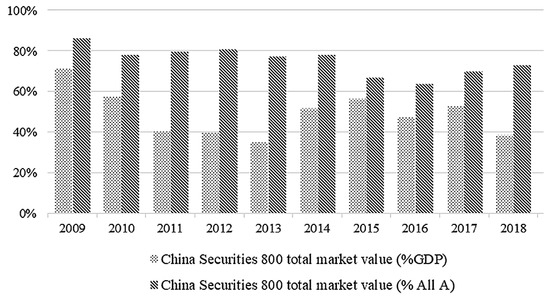
Figure 1.
Proportion of A-share stock market value and GDP of the total market value of CSI 800 (2009–2018). Data source: authors’ calculation.
Capital expenditures (Capex) can be used as a quantitative sequence of physical capital inputs. We use the perpetual inventory method to accumulate these expenditures to derive the stock of physical capital and refer to the Belo et al. [7] parameters to give a growth rate of 10% and a depreciation rate of 10%. The R&D expenses are used as a quantitative sequence of knowledge capital inputs. Employee payment costs and the number of new employees serve as quantitative sequences of labor stock inputs.
4.2. Data Processing Method
After screening the constituents of the CSI 800 index, we found 731 listed companies with 10 years of financial data. In this paper, three dimensions of data were used: R&D expenses (% of total revenue), employee payment expenses (% of total revenue), and capital expenditures (% of total revenue). Since different kinds of industries have different characteristics and capital inputs may have different impacts on firm value, we use cluster analysis to divide the companies into different kinds of industries. We first use the CITIC Securities Industry Classification Standard to classify these firms into CITIC Level 1 industries (29 industries in total). We then calculate the industry-level R&D expenses, employee payment expenses, and capital expenditures. Based on these industrial data, we use Stata to cluster these 29 industries into four kinds: labor-intensive, capital-intensive, technology-intensive, and other industries. Furthermore, these companies can be classified into these four categories. Cluster analysis is a data analysis method that can classify, reduce, and visualize the data into several categories. K-means clustering was used in our sample. K-means clustering is an algorithm used to classify our objects into K number of groups based on attributes of the objects. The grouping is done by minimizing the sum of squares of the distance between the data and the corresponding cluster centroid. The cluster results are shown in Table 1.

Table 1.
Cluster analysis results of industry categories. Data source: Authors’ calculation.
The main reason for using cluster analysis is to avoid the bias of human judgment of the attributes of individual industries. In the case of the electronic components industry, for example, the growth of capital investment in the industry over the past ten years has been significant in all three areas of research and development, labor, and capital expenditure, as shown by the financial data. In this case, it is difficult for the researcher to judge the type of industry. With the help of the cluster analysis method, after our comprehensive judgment, the electronics industry is classified as capital-intensive. Another example is the pharmaceutical industry. According to the traditional view, rising R&D costs usually occur in technology-intensive industries. According to the data, the pharmaceutical industry’s investment in R&D expenses (% share of total revenue) rose every year, from 1.1% in 2009 to 2.7% in 2018. It is easy for researchers to subjectively categorize the pharmaceutical industry as technology-intensive. However, in fact, the results of the cluster analysis show that categorizing differently would be better. The other categories are aggregated into one category mainly because the industry characteristics are not obvious and there is no significant tendency towards technology, labor, or capital in terms of data characteristics.
5. Results and Discussion
5.1. Enterprise Value Analysis
After the classification of companies and the collection and calculation of sample data, we minimized the distance between the actual price-to-book ratio and the model-implied price-to-book ratio by minimizing the distance between them, i.e., we used the Ordinary Least Squares (OLS) regression method to identify the optimal combination of parameters.
Regression analyses of the CSI 800 firm data give us the distribution of firm values across all industries and subtypes of industries. For the results obtained from the whole sample, the proportion of physical capital inputs to the market value of firms has increased from 22.0% to 25.7% over the 10-year period, the proportion of labor inputs to the market value of firms has decreased from 56.5% to 36.4%, and the proportion of knowledge capital inputs to the market value of firms has increased from 21.5% to 37.9%. Belo et al. [7] found that, for US companies, knowledge capital contributed more and more and physical capital’s contribution was decreasing while labor’s contribution stayed stable from 1975 to 2016. It can be seen that the trend in knowledge capital is the same for Chinese companies and US companies, which shows that knowledge is more and more important in the modern economy. The different trends in physical capital and labor’s contribution can be ascribed to the different development stages and labor endowments. China is still at a low development level and has large amounts of low-cost labor. Thus, labor contributes the most to firm value, and with the development of the economy, physical capital accumulates and its contribution increases (Figure 2).
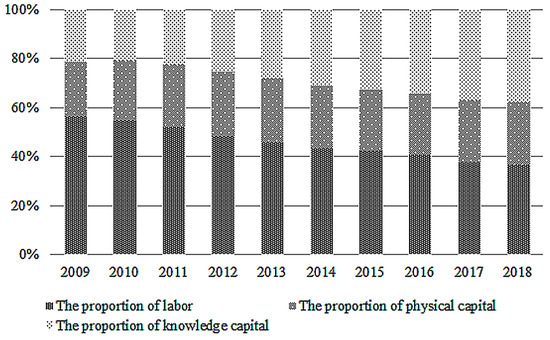
Figure 2.
Labor, physical capital, and knowledge capital of the enterprise market value proportion (2009–2018). Data source: Authors’ calculation.
This change in proportions in value decomposition is consistent with the facts. It also validates the realistic evolution of the economic transformation process that we often refer to, i.e., the gradual transformation from low-end labor-intensive industries to innovative technology-based industries. This means that, from the perspective of enterprise value, if a company’s managers want to increase the value of the company’s stock, they need to keep investing in research and development to become an innovation leader in their industry segment. From a workforce perspective, as companies create value by shifting from tedious labor-intensive work to innovation-based work, employers’ needs are also transforming from general labor to innovative talent needs. Therefore, in order to avoid being eliminated from the market, the workforce needs to upgrade their skills to be able to provide higher value-added labor outcomes.
At the meso-level, as mentioned earlier, this paper divides the CITIC level 1 industries into four broad categories: capital-intensive, labor-intensive, technology-intensive, and other industries. For different types of firms, the relative importance of physical, labor, and knowledge capital inputs to the firm’s market value varies. As shown in Figure 3, Figure 4 and Figure 5, the results of the study show the following:
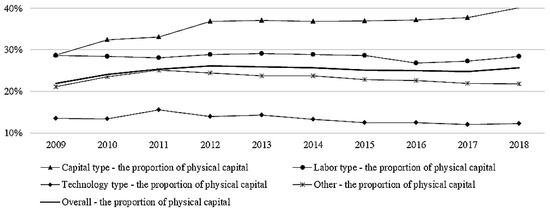
Figure 3.
Change in physical capital proportion of different types of enterprises (2009–2018). Data source: Authors’ calculation.
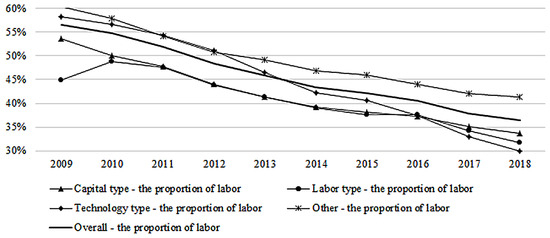
Figure 4.
Changes in labor proportion of different types of enterprises (2009–2018). Data source: Authors’ calculation.
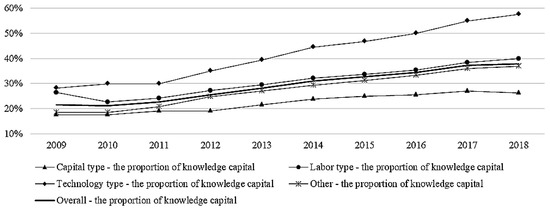
Figure 5.
Changes in knowledge capital of proportion of different types of enterprises (2009–2018). Data source: Authors’ calculation.
First, for capital-intensive industries, the proportion of physical capital input in the enterprise value increased from 28.8% in 2009 to 40.1% in 2018, while the proportion of labor input in the enterprise market value decreased from 53.7% in 2009 to 33.6% in 2018. The proportion of knowledge capital input in the enterprise market value increased from 17.5% in 2009 to 26.3% in 2018.
Second, for labor-intensive industries, the proportion of physical capital input in the enterprise market value remained at about 28.5%, and the proportion of labor input in the enterprise market value dropped from 44.8% in 2009 to 31.7% in 2018. The proportion of knowledge capital input in the enterprise market value increased from 26.5% in 2009 to 39.9% in 2018.
Third, for technology-intensive industries, the proportion of physical capital input in the enterprise market value decreased from 13.6% in 2009 to 12.3% in 2018, and the proportion of labor input in the enterprise market value decreased from 58.3% in 2009 to 30.0% in 2018. The proportion of knowledge capital input in the enterprise market value increased from 28.1% in 2009 to 57.7% in 2018.
Fourth, for other industries that do not have the above industry characteristics, the proportion of physical capital input in the enterprise market value increased from 21.2% in 2009 to 21.8% in 2018, while the proportion of labor input in the enterprise market value decreased from 60.3% in 2009 to 41.3% in 2018. The proportion of knowledge capital input in the enterprise market value increased from 18.5% in 2009 to 36.9% in 2018.
It is noteworthy that the results of the meso-level classifications (capital-intensive, labor-intensive, technology-intensive, and other industries) show a trend toward technological transformation. Typically, technological transformation of the economy in the popular sense implies an increase in the number of technological firms or an increasing share of the total market values of technological firms as a percentage of GDP. In recent years, the penetration of smartphones, mobile payments, 3G to 4G to 5G, and so on into daily life has been increasing, and the prices of all kinds of technology stocks in the financial markets have been rising. Intuitively, we may think that the share of technology-based companies in the overall economy is increasing. However, the data show that this increase has not been significant. The share of the total market value of technology-intensive firms has not increased dramatically and has grown at a rate not too dissimilar to the growth of the overall market. One possible explanation is that the data used in this study are the constituents of the CSI 800 Index, which does not include leading technology companies listed overseas, such as Alibaba, Tencent, and Meituan.
In addition, the share of the total market value of traditional labor-intensive companies has been declining every year over the past decade, from 19.7% in 2009 to 12.0% in 2018 (Figure 6 and Figure 7); in terms of the absolute volume of the total market value, labor-intensive companies still rose slightly, from CNY 5600 billion in 2009 to CNY 5800 billion in 2018, slower than the overall growth. However, we can still see that the best companies in this industry are still adding value to their businesses by increasing their R&D investment. Their R&D expenditure as a proportion of total revenue has risen every year, from 0.7% in 2009 to 2.1% in 2018 (Figure 8).
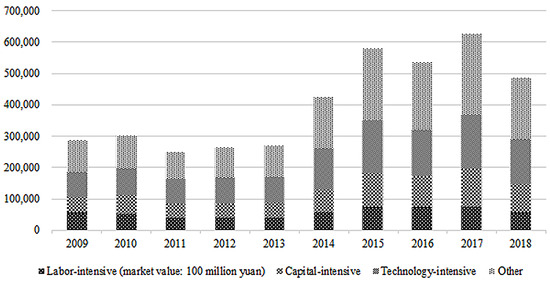
Figure 6.
Changes in market value of different types of enterprises (2009–2018). Data source: Authors’ calculation.
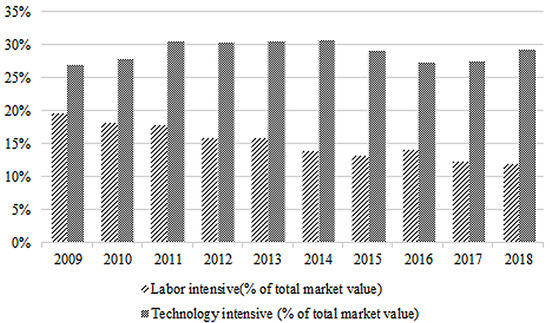
Figure 7.
Changes in the share of labor-intensive and technology-intensive firm’s total market value (2009–2018). Data source: Authors’ calculation.
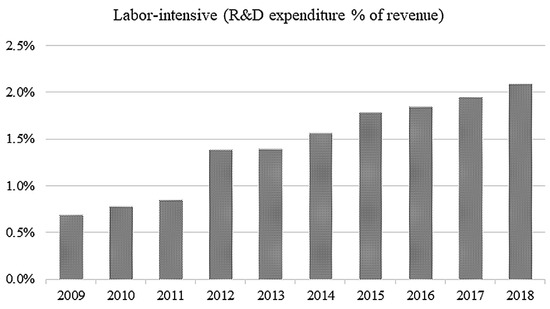
Figure 8.
Changes in the R&D expenditure proportion of revenue in labor-intensive industries (2009–2018). Data source: Authors’ calculation.
5.2. Simulation Analysis of Enterprise Optimal Investment Behavior
Based on the above results of enterprise value decomposition, we further analyze the optimal investment behavior of the enterprise using numerical simulation. We assume that the production function of the enterprise is as follows:
For simplicity, the subscript indicating enterprise characteristics is omitted. is the total productivity, is exogenous technological shock, is physical capital, is labor, and is knowledge capital. The motion of total productivity and technological shock are given using the following equations:
where is a fixed productivity level, and are the persistence coefficients of aggregate productivity and technological shock, and are the conditional volatilities, and and are i.i.d. standard normal shocks.
The accumulation equation of different types of capital is as follows:
where and are the depreciation rate of physical capital and knowledge capital, respectively, is the employee quit rate, and are the annual investment in physical capital and knowledge capital, respectively, and is the amount of newly added (or decreased) labor.
Assuming that the wage is fixed and the change in capital and labor will generate adjustment costs, the adjustment cost of each period can be expressed as follows:
The net profit of the enterprise in each period is as follows:
Assume that the product price is unit 1, and the enterprise’s goal is to select the physical capital and knowledge capital input of each period as well as the amount of newly hired labor in order to maximize the enterprise value.
To achieve maximum value, the enterprise must choose the optimal physical capital investment, labor investment, and knowledge capital investment. Without a loss of generality, we adopt the following parameters to simulate firm behavior in different states. The selection of parameters refers to Belo et al. [28], but necessary adjustments are made (Table 2).

Table 2.
Basic parameters of the simulation. Data source: Belo et al. [28] with some modifications.
Based on the above parameters, we first write a function to calculate the value function at given investment levels, and then, with the help of the Matlab fminbnd function, we can obtain the maximum firm value and optimal capital investments for different cases. Matlab R2016a was used for the simulation.
5.2.1. Relationship between Physical Capital Investment and Physical Capital Stock
Enterprises are divided into high-technology enterprises and low-technology enterprises according to their types, with corresponding -values of 1.1 ( high) and 1.0 ( low), respectively. As for the relationship between enterprise market value () and physical capital stock , it can be seen from Figure 9 that the higher the physical capital stock, the higher the technical level, the greater the enterprise value, and the distance between high-tech enterprises and low-technology enterprises will gradually expand. For the relationship between physical capital investment and physical capital stock , it can be seen that when the physical capital is low, the investment in physical capital should continue to increase, that is, should increase. However, when the physical capital is high, the physical capital investment can be appropriately reduced. It is worth noting that new investment in physical capital is negative when physical capital is very high. On the whole, there is an inverted U-shaped relationship between the investment of physical capital and the stock of physical capital. In addition, the higher the technological level (z value), the more physical capital investment can be maintained.
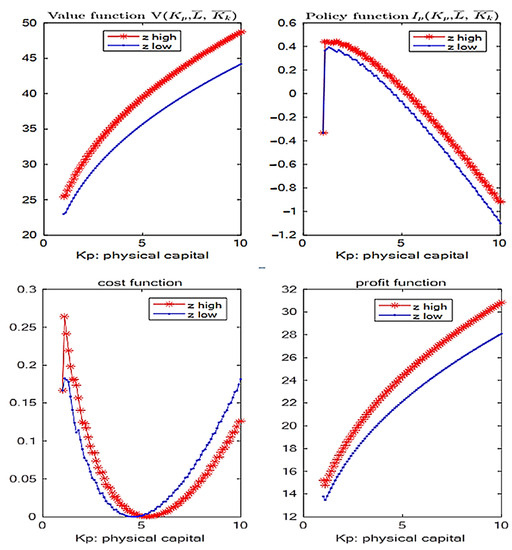
Figure 9.
Simulation results of the relationship between physical capital investment and physical capital stock. Data source: Authors’ simulation.
For the relationship between the adjustment cost and the physical capital stock (), the cost function is , and increases gradually and then decreases gradually, so the cost function presents a U-shape with the increase in the physical capital stock. When the capital stock is small, is large and is small, so the cost is large. When is 0, the cost is 0. However, when the capital stock is large, is negative, the absolute value of gradually increases, and gradually decreases, so the cost gradually increases. As for the relationship between the profit and the physical capital stock (), it can be seen that although the adjustment cost changes in a curvilinear form, because the enterprise can choose the optimal adjustment method to arrange the production, with the increase in capital stock, the profit increases gradually.
5.2.2. Relationship between Recruitment and Labor Stock
Enterprises are similarly divided into high-technology enterprises and low-technology enterprises according to their types, with corresponding z-values of 1.1 (z high) and 1.0 (z low), respectively. As for the relationship between enterprise market value (V) and labor stock (), it can be seen from Figure 10 that the larger the labor force and the higher the technology level, the greater the enterprise value. When the enterprise is short of labor force, it should constantly add new labor force, and when the labor force reaches a certain level, it should reduce the growth rate of the labor force until it is stable at a certain level. The higher the technical level, the more the labor force can be used effectively. Beyond a certain level, the new labor force is only used to make up for the separating staff.
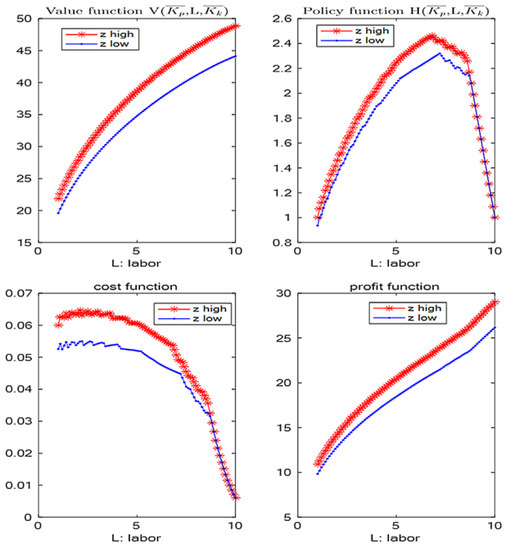
Figure 10.
Simulation results of the relationship between recruitment and labor stock. Data source: Authors’ simulation.
Although the cost function is , since is always positive, keeps increasing until it reaches an optimal level. Therefore, with the small increase in , keeps increasing, and the cost shows an increasing trend. However, with the increase in , gradually decreases. So, the cost becomes smaller. Since firms can adjust their production level according to the available labor, more labor leads to greater profits.
5.2.3. Relationship between R&D Investment and Knowledge Capital Stock
Enterprises are similarly divided into high-technology enterprises and low-technology enterprises according to their types, corresponding to z values of 1.4 (z high) and 1.0 (z low), respectively. As shown in Figure 11, the higher the knowledge capital, the higher the technology level and the greater the enterprise value. At the stage of low technology level, and low knowledge capital, the income brought by knowledge capital investment cannot cover the cost, so the best choice is to reduce the investment in this area and devote more resources to production. When the knowledge capital stock exceeds a certain level, knowledge investment can bring positive returns, so it is necessary to increase knowledge investment to make up for the adverse effects of knowledge capital depreciation. When the knowledge capital stock reaches a high level, the speed of knowledge investment should be slowed down. If the overall technology level is low, the knowledge capital stock may need to be reduced.
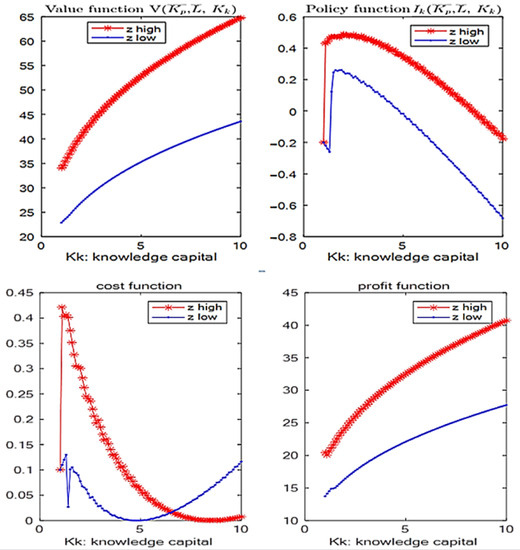
Figure 11.
Simulation results of the relationship between R&D investment and knowledge capital stock. Data source: Authors’ simulation.
Since the cost function is assumed to be , the adjusted cost coefficient and the depreciation rate of knowledge capital are both large and the cost is high at the low stage and decreases with the increase in knowledge capital. When the knowledge capital is large, the depreciation of the knowledge capital needs more R&D investment and the adjustment cost increases. Thus, similarly to physical capital, the cost function of knowledge capital shows a U-shaped trend. The higher the knowledge capital and the higher the level of technology, the higher the profit the firm can obtain.
6. Conclusions
The empirical results show that the average proportion of physical capital in the enterprise market value increased from 22.0% in 2009 to 25.7% in 2018 in the whole sample (the constituents of the China Securities 800 Index). The average share of labor decreased from 56.5% in 2009 to 36.4% in 2018. The average share of knowledge capital increased from 21.5% in 2009 to 37.9% in 2018. The same trends can be seen in all four types of industries. In particular, in technology-intensive industries, the proportion of knowledge capital in enterprise value increased from less than 30% in 2009 to 56.5% in 2018. This means that knowledge capital is an important, if not decisive, component of the market value of technology-intensive firms.
The growing importance of knowledge capital diminishes the importance of labor. This finding also coincides with China’s economic transformation. Physical capital does not show a clear trend for the market value of enterprises and remains relatively stable. The decline in the share of labor in the market value of firms corresponds to an increase in the contribution of knowledge capital to the value of firms. This trend occurs in labor-intensive, capital-intensive, and technology-intensive industries (although the change is more visible in technology-intensive industries).
Simulations of firms’ investment behavior show that it is not always better to invest more in physical capital, labor, or knowledge capital. Firms need to make optimal decisions based on the level of technology and current capital stock. Moreover, the firm value distance between high-technology firms and low-technology firms will gradually increase. With a higher level of technology, more labor can be used efficiently, and greater firm value can be obtained. Although the more physical, labor, and knowledge capital a firm has, the greater the value of the firm, too much investment leads to larger adjustment and adaptation costs and also accelerates the amount of depreciation of capital, as new inputs bring adjustment costs. Therefore, enterprises must invest and expand moderately according to the actual situation.
The following policy recommendations are made:
First, firms need to pay more attention to R&D investment. Empirical results show that the importance of knowledge capital is rising gradually each year. Moreover, this trend is present in all sectors, not just technology-intensive ones. Currently, some industries (e.g., the food and beverage industry) are still stuck in channel expansion and brand marketing investment while ignoring the benefits of technological improvement. This has a detrimental effect on the development of the industry. Technological transformation is a process that every industry needs to go through.
Second, China needs to be more vigilant about labor shortages. From the perspective of population size, the growth rate of China’s labor force will further decline; from the perspective of wages, the minimum wage and various employee benefits are also gradually increasing. It can be predicted that the average labor cost growth rate will be higher than the economic growth rate in the future. Although the empirical results show that the labor share (% enterprise market value) has declined over the past decade and the share of enterprise market value of knowledge capital has risen, the sustained rise in labor costs may lead to an increase in the total costs of enterprises, which will in turn crowd out the enterprises’ relevant inputs of knowledge capital and physical capital. The Chinese government may consider fully liberalizing its fertility policy so as to prepare policies to alleviate the long-term labor shortage problem.
Third, the effectiveness of capital investment should be improved. In the past, firms could receive subsidies from the Chinese central or local governments for various capital investments (e.g., building factories and buying equipment). Firms did not pay much attention to capital investment in technological upgrading. With the phasing out of government subsidies (e.g., in the new energy automotive sector) and the opening of China’s market, the number of foreign companies coming to China is increasing, and their business scope is expanding. Increased competition has further prompted Chinese domestic investors to think about how to improve the effectiveness of their capital investments. Therefore, the government should regularly encourage and guide companies to enhance their capital investments to avoid losing the industry’s global competitiveness.
There are some limitations to this research. First, the theoretical model only considers the behaviors of the firm without considering households or consumers. A more general model that includes firms, households, and government can give us more interesting insights. Second, the measurement of knowledge capital is calculated using R&D investment; however, as Das and other researchers [42,43] pointed out, R&D may not bring direct firm performance or economic growth, and some firms may use R&D to enact some symbolic innovations for government subsidies. A more direct measurement and detailed analysis of knowledge capital is needed. Third, we only investigated the firm value decomposition trend before the COVID-19 pandemic. Studying the effect of this pandemic on firm values and behaviors would constitute important and interesting research; however, this may need a new model to take into account a great shock. Fourth, we decomposed the firm value using the neoclassical investment model, which contains physical capital, labor, and knowledge capital. There are some studies that used intellectual capital theory and models to explain the firm value. A detailed analysis to compare the assumptions and empirical evidence would be useful for understanding the determinants of firm values.
Author Contributions
Conceptualization, Z.H.; Methodology, Y.Q. and X.S.; Software, Y.Q. and X.S.; Formal analysis, H.D.; Resources, Z.H.; Data curation, Z.H.; Writing—original draft, X.S. and Z.H.; Writing—review & editing, Y.Q. and H.D.; Supervision, Y.Q. All authors have read and agreed to the published version of the manuscript.
Funding
This research was funded by Shandong Provincial Social Science Foundation grant number 23CJJJ21.
Data Availability Statement
Publicly available datasets were analyzed in this study. This data can be found here: https://www.wind.com.cn/.
Conflicts of Interest
The authors declare no conflict of interest.
References
- Abel, A.B. A stochastic model of investment, marginal q and the market value of the firm. Int. Econ. Rev. 1985, 26, 305–322. [Google Scholar] [CrossRef]
- Gonçalves, A.S.; Xue, C.; Zhang, L. Aggregation, capital heterogeneity, and the investment CAPM. Rev. Financ. Stud. 2020, 33, 2728–2771. [Google Scholar] [CrossRef]
- Chirinko, R.S. Multiple capital inputs, Q, and investment spending. J. Econ. Dyn. Control 1993, 17, 907–928. [Google Scholar] [CrossRef]
- Hayashi, F.; Inoue, T. The relation between firm growth and Q with multiple capital goods: Theory and evidence from panel data on Japanese firms. Econometrica 1991, 59, 731–753. [Google Scholar] [CrossRef]
- Ni, Y.; Cheng, Y.R.; Huang, P. Do intellectual capitals matter to firm value enhancement? Evidences from Taiwan. J. Intellect. Cap. 2021, 22, 725–743. [Google Scholar] [CrossRef]
- Smriti, N.; Das, N. The impact of intellectual capital on firm performance: A study of Indian firms listed in COSPI. J. Intellect. Cap. 2018, 19, 935–964. [Google Scholar] [CrossRef]
- Belo, F.; Gala, V.D.; Salomao, J.; Vitorino, M.A. Decomposing firm value. J. Financ. Econ. 2022, 143, 619–639. [Google Scholar] [CrossRef]
- Wang, M.C. Value relevance of Tobin’s Q and corporate governance for the Taiwanese tourism industry. J. Bus Ethics. 2015, 130, 223–230. [Google Scholar] [CrossRef]
- Li, X. The development of digital economy and the enhancement of enterprise value—Based on the perspective of life cycle theory. Econ. Probl. 2021, 3, 116–121. [Google Scholar]
- Huang, D.; Xie, H.; Meng, X.; Zhang, Q. Digital transformation and enterprise value: Empirical evidence based on text analysis methods. Economist 2021, 12, 41–51. [Google Scholar]
- Xu, Y.; Yang, X.; Liu, J. Information Density, Social Trust and Enterprise Value Creation. China Soft Sci. 2022, 1, 98–110. [Google Scholar]
- Chen, X.; Wu, J.; Lian, Y. Elasticity of capital-labor substitution, partial technological progress and factor relative income share of Chinese industrial firms. Econ. Sci. 2019, 4, 81–91. [Google Scholar]
- Yan, X.; Kong, A. The enhancement effect of managerial ability on firm value: From perspectives of market competition and local protection. Fudan J. 2021, 63, 172–183. [Google Scholar]
- Abel, A.B. Optimal investment under uncertainty. Am. Econ. Rev. 1983, 73, 228–233. [Google Scholar]
- Belo, F.; Xue, C.; Zhang, L. A supply approach to valuation. Rev. Financ. Stud. 2013, 26, 3029–3067. [Google Scholar] [CrossRef]
- Andrei, D.; Mann, W.; Moyen, N. Learning and the Improving Relationship between Investment and q; Unpublished Working Paper; University of California: Los Angeles, CA, USA, 2018. [Google Scholar]
- Hall, R.E. The stock market and capital accumulation. Am. Econ. Rev. 2001, 91, 1185–1202. [Google Scholar] [CrossRef]
- McGrattan, E.R.; Prescott, E.C. Is the Stock Market Overvalued? Q. Rev. Fed. Reserve Bank Minneap. 2000, 24, 20–40. [Google Scholar] [CrossRef]
- Corrado, C.A.; Hulten, C.R.; Sichel, D.E. Intangible capital and US economic growth. Rev. Income Wealth 2009, 55, 661–685. [Google Scholar] [CrossRef]
- Li, E.X.N.; Liu, L.X.L. Intangible assets and cross-sectional stock returns: Evidence from structural estimation. SSRN Electron. J. 2012. [Google Scholar] [CrossRef][Green Version]
- Corrado, C.A.; Hulten, C.R. How do you measure a “technological revolution”? Am. Econ. Rev. 2010, 100, 99–104. [Google Scholar] [CrossRef]
- Hansen, L.P.; Heaton, J.C.; Li, N. Intangible risk. In Measuring Capital in the New Economy; University of Chicago Press: Chicago, IL, USA, 2005; pp. 111–152. [Google Scholar]
- Falato, A.; Kadyrzhanova, D.; Sim, J.; Steri, R. Rising intangible capital, shrinking debt capacity, and the U.S. corporate savings glut. J. Financ. 2022, 77, 2799–2852. [Google Scholar] [CrossRef]
- Peters, R.H.; Taylor, L.A. Intangible capital and the investment-q relation. J. Financ. Econ. 2017, 123, 251–272. [Google Scholar] [CrossRef]
- Eisfeldt, A.L.; Papanikolaou, D. Organization capital and the cross-section of expected returns. J. Financ. 2013, 68, 1365–1406. [Google Scholar] [CrossRef]
- Lev, B.; Radhakrishnan, S. The valuation of organization capital. In Measuring Capital in the New Economy; University of Chicago Press: Chicago, IL, USA, 2005; pp. 73–110. [Google Scholar]
- Gourio, F.; Rudanko, L. Customer capital. Rev. Econ. Stud. 2014, 81, 1102–1136. [Google Scholar] [CrossRef]
- Belo, F.; Lin, X.; Vitorino, M.A. Brand capital and firm value. Rev. Econ. Dynam. 2014, 17, 150–169. [Google Scholar] [CrossRef]
- Al-Khoury, A.; Hussein, S.A.; Abdulwhab, M.; Aljuboori, Z.M.; Haddad, H.; Ali, M.A.; Abed, I.A.; Flayyih, H.H. Intellectual Capital History and Trends: A Bibliometric Analysis Using Scopus Database. Sustainability 2022, 14, 11615. [Google Scholar] [CrossRef]
- Rehman, S.U.; Bresciani, S.; Ashfaq, K.; Alam, G.M. Intellectual capital, knowledge management and competitive advantage: A resource orchestration perspective. J. Knowl. Manag. 2022, 26, 1705–1731. [Google Scholar] [CrossRef]
- Lin, Y.M.; Lee, C.C.; Chao, C.F.; Liu, C.L. The information content of unexpected stock returns: Evidence from intellectual capital. Int. Rev. Econ. Financ. 2015, 37, 208–225. [Google Scholar] [CrossRef]
- Shafiee, M.M. Competitive advantage via intellectual capital: A moderated mediation analysis. J. Intellect. Cap. 2022, 23, 957–997. [Google Scholar] [CrossRef]
- Shapiro, M.D. The dynamic demand for capital and labor. Q. J. Econ. 1986, 101, 513–542. [Google Scholar] [CrossRef]
- Hall, R.E. Measuring factor adjustment costs. Q. J. Econ. 2004, 119, 899–927. [Google Scholar] [CrossRef]
- Merz, M.; Yashiv, E. Labor and the Market Value of the Firm. Am. Econ. Rev. 2007, 97, 1419–1431. [Google Scholar] [CrossRef]
- Belo, F.; Lin, X.; Bazdresch, S. Labor hiring, investment, and stock return predictability in the cross section. J. Polit Econ. 2014, 122, 129–177. [Google Scholar] [CrossRef]
- Barkai, S. Declining labor and capital shares. J. Financ. 2020, 75, 2421–2463. [Google Scholar] [CrossRef]
- Cochrane, J.H. Production-based asset pricing and the link between stock returns and economic fluctuations. J. Financ. 1991, 46, 209–237. [Google Scholar] [CrossRef]
- Ohlson, J.A. Earnings, book values, and dividends in equity valuation. Contemp. Account. Res. 1995, 11, 661–687. [Google Scholar] [CrossRef]
- Liu, L.X.; Whited, T.M.; Zhang, L. Investment-based expected stock returns. J. Polit Econ. 2009, 117, 1105–1139. [Google Scholar] [CrossRef]
- Hayashi, F. Tobin’s marginal q and average q: A neoclassical Interpretation. Econometrica 1982, 50, 213–224. [Google Scholar] [CrossRef]
- Das, R.C. Interplays among R&D spending, patent and income growth: New empirical evidence from the panel of countries and groups. J. Innov. Entrep. 2020, 9, 18. [Google Scholar]
- Das, R.C.; Mukherjee, S. Do spending on R&D influence income? An enquiry on the world’s leading economies and groups. J. Knowl. Econ. 2020, 11, 1295–1315. [Google Scholar]
Disclaimer/Publisher’s Note: The statements, opinions and data contained in all publications are solely those of the individual author(s) and contributor(s) and not of MDPI and/or the editor(s). MDPI and/or the editor(s) disclaim responsibility for any injury to people or property resulting from any ideas, methods, instructions or products referred to in the content. |
© 2023 by the authors. Licensee MDPI, Basel, Switzerland. This article is an open access article distributed under the terms and conditions of the Creative Commons Attribution (CC BY) license (https://creativecommons.org/licenses/by/4.0/).